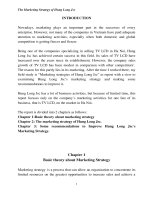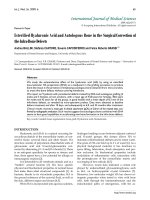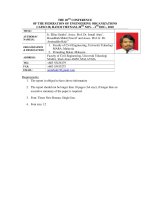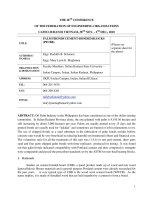Cultural integration - The inevitable trend of exogenous religions in Vietnam in general and of protestantism in particular
Bạn đang xem bản rút gọn của tài liệu. Xem và tải ngay bản đầy đủ của tài liệu tại đây (429.43 KB, 8 trang )
Religious Studies Review. Vol. 6, No. 3 & 4 - 2012
18
CULTURAL INTEGRATION - THE INEVITABLE TREND
OF EXOGENOUS RELIGIONS IN VIETNAM IN GENERAL
AND OF PROTESTANTISM IN PARTICULAR
NguyÔn Quèc TuÊn
The
(*)
two concepts
of
Culture
and
Religion,
in everyday
life,
seem
separating in the view of all people and perhaps not even a few persons have
to pay attention. Then what are the problems between the national culture
and the large exogenous religions In the case of Vietnam that should be
noted? Whatever presented in this essay may pose a view that is still humble
about the main topic as stated, a personal solution, with several points that
we need to discuss.
To evaluate these issues, it is necessary to recognize the problems from
historical aspects with a broad view. Throughout the course of history, Vietnam
has gone through many events, but changes in Vietnamese history followed
long cycles, and the following developments always reserved many elements of
the previous time, and the history of religion and culture in Vietnam had no
exception. People by themselves have to raise questions:
- How the exogenous religions (Buddhism, Hinduism, Taoism, Confucianism,
Islam, Catholicism, Protestantism,…) having propagated for more than a
thousand years could have a firm status in the spiritual and cultural life of the
whole nation -the people, also over the time penetrated deeper, in spite of the
vicissitude of economic life and social form?
- Further questioning these religions, in the process of propagating and
existing, have they transformed themselves to mix in with the lives of the
people who cultivated rice (wet rice cultivation or dry rice cultivation ) as the
*
Dr., Institute for Religious Studies, Vietnam Academy of Social Sciences.
This was the writer’s paper in the 3rd Roundtable on Protestantism and Vietnam Culture
organized in Hanoi on 28th Nov. 2012 by co-organizers Institute for Religious Studies, the
Vietnam - USA Society and Institute for Global Engagement.
Nguyễn Quốc Tuấn. Cultural Integration…
19
main source of living, the people who did not have habits of expressing
through use of text, writing, grant theories, but used usual language, customs,
traditions, norms, signs of symbolic and characteristic actions, feelings of a
simple soul, but containing the basis of deep thoughts, eventually receiving the
essence of external religious doctrines?
- Furthermore, what were the inadequate points from the exogenous
religions when spreading their knowledge outside, seemingly there were
religions that were unfit for the national culture?
Perhaps this integration brought to Vietnamese culture some new spiritual
colors. On one hand, it confirmed what it had; on the other hand, it also gave
new contributions (though not always synonymous with goodness), and the
important result created the Vietnamese people and soul as they are today. Who
could deny the values that Buddhism, Hinduism, Taoism, and Confucianism
have brought to the Vietnamese people and other ethnic people of Vietnam,
from ethics, ways of life to economics, politics, ideology and transcendent
thought. Who can show evidence of futility that Hinduism, Islam brought to the
Cham people’s culture? Likewise, the Catholics and the Protestants in Vietnam
have their own reason to talk about the advantages that their religions
brought? The reason is that to say there were no "advantages", why certain
ethnic people of Vietnamese nation would follow them, although these two
religions did not have the same cultural "origin" and their propagating time
was still relatively new in contrast with the other religions.
To this point, the important eras in the religious history of Vietnam must be
mentioned. There are at least four eras to pay attention to:
- The era before Christ (BC) and Anno Domini (AD),
- The 10th and the 11th centuries,
- The 14th century,
- And finally the twentieth century.
Approximately each cycle lasted seven or eight hundred years in the
religious history of Vietnam, left a deep imprint in spiritual life at that time
and in later periods. Those four important milestones showed the different
cycles, long and short, sometimes entering into the common flow of religions in
the region and in the world, but also taking their own rhythm steps.
Religious Studies Review. Vol. 6, No. 3 & 4 - 2012
20
The first era to pay attention to in the religious history of Vietnam is the
time around one or two centuries BC and AD. During that time, the propagating
waves of Buddhism and Hinduism to the ancient Asian countries showed a
characteristic of similarity between the two religions, and they even joined
each other to enter the new lands. With a broad view, the entire territory of
Vietnam at the time, although it was not yet a unified country as it is presently,
was influenced by the Indian religious waves. What was in those waves that
some people did not adequately evaluate is that through religion Indian
civilization
entered
the
new
lands
and
left
there
traces
of
splendid
architectures, arts, writing, which are still can be seen today in Asian countries.
The Indians not only promoted their own religions, but they also transferred
other religions of the world in the next centuries to enter the Asian countries,
as an example, Islam. With a closer view, the propagation of Buddhism to Viet
Nam and ancient Indochina peninsula caused different consequences. For
example, when Buddhism came to North Vietnam, Chinese civilization had
already established a firm position. Therefore, Buddhism and Hinduism had to
find a way to coexist; they could not have the superposition as they had in
South Vietnam and in other parts of the Indochina peninsula. In the period
around before Christ (BC) and After Domini (AD), South China and North
Vietnam suffered a formidable religious wave case stirred up by Chinese rulers:
religions like Confucianism and Taoism. Disregarding minor details, it was an
unprecedented force in the history of the Bach Viet people at that time. It was a
force because the Vietnamese aborigines have had a long traditional culture
and their own religions that researchers refer to as Animism (1) and Polytheism,
and along with these religions, there were ceremonies, festivals that took place
in the seasonal cycle of cultivation and weather of small communities
(communes or villages) or regional communities. We can find numerous proofs
of these religions in the lives of the Vietnamese people and other ethnic groups
at the present time. Animism does not has a form of existence like the large
religions (also referred to as established religion and redemptive religion, and
many large religions have their own origins and undeniable traces of
Animism) established on the foundation of ancient civilizations. Through a
Animism, the doctrine of this religion believe in attached the concept of soul for every animal,
every natural phenomenon and every object, we can use Vietnamese idioms of the soul of
banyan tree and kapok tree to express this definition.
1
Nguyễn Quốc Tuấn. Cultural Integration…
21
different perspective, the large religions and Animism have no heterogeneous
levels of reflection in the human religious sense that was derived from the
“regular” phenomenon of the uneven development in human history, as C. LÐviStrauss
(2)
commented: that is a cumulative and gradual process. It means that
civilization (or religion) cannot be equally shared among humanity at the same
time. If we based on the evidence of written data and objects, which existed, we
certainly know that at the time of 3000 BC, Animism and Polytheism dominated
the whole religious life of humanity. Yet until now, we still find that they
concurrently exist and intrude into the large religions despite the fact that
time and historical circumstances have changed.
Looking back to the primary centuries AD and the period ruled by the
Chinese in the North, there may be the situation: when Animism and polytheism
dominated the life of the rural communes in Vietnam, the large religions of
China and India were basically concentrated just around the bases of the rulers.
This situation did not exclude part of the countries in southern Vietnam,
Champa and Phu Nam (Funan). It can be inferred that the large religions
sought to interfere with the spiritual foundation of the indigenous agricultural
society that had existed as a type of the rural commune of Asian mode of
production. We can just infer because there was no event that could be proven
with certainty in time and space of the interfering process, especially in the
situation of Chinese rulers seeking to assimilate the indigenous populations.
Their bibliographies always described the nations and the ethnic neighbors in
a model way. In contrast, the nations and the ethnic groups influenced by
Indian civilization have borrowed the expressions of Indian bibliography to
express their culture.
The second noteworthy period of the religious history of Vietnam is the 10th
and the 11th centuries, the beginning of the era of autonomy and independence
of Dai Viet. By that time, Vietnamese agricultural rice civilization had
established its own appearance. It sufficiently converged the factors of a
uniform regime as a centralized monarchy, the king and the royal apparatus
reigned over numerous rural communes.
C. LÐvi-Strauss, Race and History, translation, The Society of History Science of Vietnam,
Hanoi, 1996.
2
Religious Studies Review. Vol. 6, No. 3 & 4 - 2012
22
There was an unexpected tendency in history: what foreign rulers in the
North imposed on the Vietnamese in the past thousand years but failed were
applied and completed by the Vietnamese monarchy when bringing Chinese
civilization to impose on the nation, including the religions in the 10th and 11th
centuries. These events have molded the face of Vietnamese culture for many
centuries
later.
The
next
generations
often
identified
this
frame
with
traditional ethnic culture. NguyÔn Tr·i confirmed that it was at the highest
level when he equated Vietnamese civilization with Chinese civilization. The
large religions at the time were Buddhism, Confucianism, and Taoism, often
referred to as the tri-religion in history books. To pass the time and through
the Vietnamese monarchies, these religions have managed the spirit of the trireligion coexisting. We can point out a few key points of this process. They
were actively supported, honored and imposed on the rural communes-villages
of the state. The cases -as Buddhism, Taoism under the Ly and the Tran
dynasties, Confucianism under the Le and the Nguyen dynasties- were typical
for the imposition. This trend was more determined, conservative, and rigid
along the time. The states in the south were not different when receiving
Hinduism and then Islam.
At the beginning of the Dai Viet civilization, it was phenomenal that the
large religions have actively participated in the social and political life, and
the Buddhist monks and Taoist clergymen had a huge role in the construction
of the dynasty. There is no doubt that the totalitarianism of Confucianism has
dominated every aspect of life in the society during the periods of Le-Nguyen
dynasties. In fact, Confucianism had to give a concession to Buddhism, Taoism
and Animism. In the south, Buddhism, Confucianism, Taoism also faced with
Hinduism and Islam.
However, the new and positive factors of the large religions that have
contributed to the nation’s cultural heritage should be mentioned. These
religions were very important sources in the creation of written and imperial
culture (mainly the Chinese figurative square block's character and sharp
horizontal Indian character as Sanskrit and Pali). These religions inspired the
creation of national language and script. They meant to transfer cultural
values, just as a bridge for indigenous culture and exogenous exchange, and
have also been a means for Vietnam to join the common culture of humanity in
the contemporary. It is necessary to emphasize the features of the religious
Nguyễn Quốc Tuấn. Cultural Integration…
23
activities of the Dai Viet period that there were no wars in the name of a
religion literally. Of course, it could not avoid discrimination, depending on
how each State honored which religions and doctrines.
However, the religious life throughout centuries has shown that the large
religions could not make Animism and Polytheism vanish. They just sank in the
bottom and flowed as an underground circuit in the heart of the communesvillages. Their actual presence has forced the state to recognize and treat them
as an essential part in the religious life of the nation. The recognition of the
Patron God of the village is the most typical example. In their turn, the large
religions had to seek popular beliefs and practices, turned them into a part of
the ritual and festival of Buddhist temple, Taoist temple and village. This is a
two-sided behavior of the state and those who were responsible in religion: on
one hand, they regarded the popular worships as "nonsense", but on the other
hand, they had to use these worships to be able to integrate into the lives of the
farmers, the subjects of Dai Viet society. In terms of religious behavior, the
throne of the Buddha was not different from the throne of the Divine in the
view of the people. What can be better than the example of the existence of the
indigenous religions through village festivals in the spring and in the autumn
with agricultural rituals and surviving ancient fertility rites? Obviously, the
characteristic can be seen through the religious spirit of the Vietnamese
history: the spirit that did not value theory and doctrine as practicality and
harmony, the spirit that did not uphold ancient things but did not break
tradition, the spirit of reception but did not totally renovate.
The third remarkable period in the religious history of Vietnam is the 16th
century. That was the time of propagation of Christianity
. In the context of
(3)
the world, capitalism has formed in Europe and was expanding into other
continents. The trend of geographical discovery and colonial conquest, in order
to expand the market and resources, Christianity, one of the world's largest
religions,
has
supported
these
expansions
with
two
largest
branches:
Catholicism and Protestantism. Vietnam and other countries in Asia were also
caught up in the cycle of the era of capitalist expansion.
The missionaries went to every place they could. They brought Christian
dogma and ritual, moreover, spread the Christian culture wherever they
3
Christianisme in French.
Religious Studies Review. Vol. 6, No. 3 & 4 - 2012
24
infiltrated. In Western literary work at the time and later, they were regarded
as brave, holy and ascetic friars who spread the faith without tiredness.
Although deaths caused by war and persecution stalked them, they gradually
formed another kind of culture and religion where they could come. A minority
of them was assimilated into the indigenous population, and understanding the
customs, appreciating cultural values of the indigenous people, and with
European manner, they wrote their experience and created a collection of
detailed
and
extensive
documents
about
the
ethnic
people.
Later
these
documents were used by social sciences and humanities researchers of the
countries that escaped from colonialism. A few of them, moreover, made some
contribution to create the writing (of course using Western characters) for the
natives. Nothing is better than taking the national writing (Quèc ng÷) of
Vietnam as an example. To be truly Objective, there were negative sides of the
Christian movement of expansion: if we affirmed the achievements that this
movement brought to the new lands, this movement was also closely associated
with Western colonialism, a very typical relationship between religion and
politics. Achievements of Christianity coincided with the pain and sufferings of
the people in the colonies. A number of missionaries actively participated in the
process of colonization, while others were less active in this movement but
supported the intention of using it as a measure to quickly expand influence,
not just merely for religion but also for the institution, the state of the Vatican.
It is a paradox of history. Coming together with newness are blood and tears,
divisions and discrimination. Although self-justification to whatever extent
and for whatever purpose, the Western colonial centuries and Christianity in
parallel still remain a dark mark in the history of religion in general and
Christianity in particular.
Nowadays, we need to have a fair view. We cannot let the past haunt us
because the nature of our culture is openness, tolerance, understanding and
continuity. Let’s raise the noble spirit as an immortal spirit in every direction,
the people for the peaceful society.
To pay attention, the relationship between Christianity and other large
religions in Vietnam at the time was not always completely good, not to say
that they even humiliated one another. Thus, in our opinion, cultural collision
obviously has to occur in that cultural and social context. But in general, the
peoples who settled by the rivers and the sea were not included in the four
Nguyễn Quốc Tuấn. Cultural Integration…
25
groups of people (Tø D©n- intellectuals, farmers, craftsmen, businessmen), or
even some people from the four groups at the later time, did not have
disapproving attitude. They also quickly found in Christianity a new place of
spiritual life for hardship. Expansion In the later time and different historical
situations of the branches of Christianity, though have changed, Christian
culture became a part of the culture of Vietnam.
The 20th century is the fourth period to be noted in the religious history of
Vietnam. There were many religious trends and philosophical movements
coexisting and fighting. It was the period of religious crisis and separation, but
some religions revived and integrated into the trend of development of society,
culture and contemporary civilization on the basis of human perception with
great changes. A century of vibration and full of world-scale events, once again,
religions are in the center of human thinking. Vietnam is not exceptional. This
century has clearly shown two trends of religious intolerance and tolerance
coinciding, occurring in Vietnam.
To conclude this presentation with a comment: All the exogenous religions,
when they come to Vietnam, they need to integrate into the national culture,
they need to show adaptation to the national culture. To adapt or not doesn't
depend solely on the national culture but depends on the exogenous religions
themselves. /.









